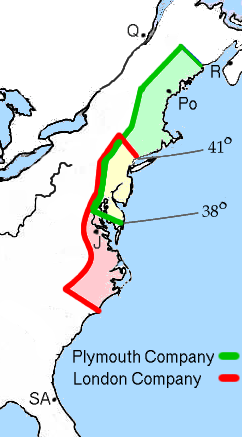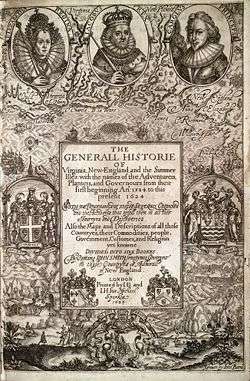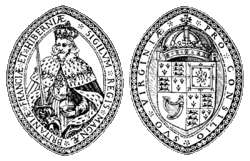Virginia Company

The Virginia Company refers collectively to two joint stock companies chartered by James I on 10 April 1606[1][2][3] with the purposes of establishing settlements on the coast of North America.[4] The two companies, called the "Virginia Company of London" (or the London Company) and the "Virginia Company of Plymouth" (or Plymouth Company) operated with identical charters but with differing territories. An area of overlapping territory was created within which the two companies were not permitted to establish colonies within one hundred miles of each other. The Plymouth Company never fulfilled its charter, and its territory that later became New England was at that time also claimed by England.
As corporations, the companies were empowered by the Crown to govern themselves, and they ultimately granted the same privilege to their colony. In 1624, the Virginia Company failed; however, its grant of self-government to the colony was not revoked, and, "either from apathy, indecision, or deliberate purpose," the Crown allowed the system to continue. The principle was thus established that a royal colony should be self-governing, and this formed the genesis of democracy in America.[5]
The Plymouth Company
The Plymouth Company was permitted to establish settlement(s) between the 38th parallel and the 45th parallel (roughly between the upper reaches of the Chesapeake Bay and the current U.S.-Canada border) On 13 August 1607, the Plymouth Company established the Popham Colony along the Kennebec River in present-day Maine. However, it was abandoned after about 1 year, and the Plymouth Company became inactive.
With the religious Pilgrims who arrived aboard the Mayflower, a successor company to the Plymouth Company eventually established a permanent settlement in Plymouth, Massachusetts in 1620 in what is now New England.
The London Company

By the terms of the charter, the London Company was permitted to establish a colony of 100 miles square between the 34th parallel and the 41st parallel (approximately between Cape Fear and Long Island Sound), and also owned a large portion of Atlantic Ocean and inland Canada.
On 14 May 1607, the London Company established the Jamestown Settlement about 40 miles inland along the James River, a major tributary of the Chesapeake Bay in present-day Virginia. The future of the settlement at Jamestown was precarious for its first 5 years. The president of the third Jamestown Council, Captain John Smith, was a difficult personality and a formidably arrogant military man who initiated a series of encounters with indigenous people the results of which would resonate negatively for at least the next four hundred years among Native Americans. Dr. Linwood Custalow's book The Real Story of Pocahontas details the story of some of Smith's most famous interactions with the Powhatan tribes from an indigenous perspective.
In 1620 George Calvert asked King James I for a charter for English Catholics to add the territory of the Plymouth Company. Also in 1609, a much larger Third Supply mission was organised. Rushed into service without the customary sea trials, the new purpose-built ship, the Sea Venture, became flagship of the fleet of 9 ships, with most of the leaders, food, and supplies aboard. Notable persons aboard the Sea Venture included the Admiral of the fleet, George Somers, Vice-Admiral Christopher Newport, the new governor for the Virginia Colony, Sir Thomas Gates, future author William Strachey, and businessman John Rolfe with his pregnant wife.
The Third Supply convoy encountered a massive storm believed to have been a hurricane which lasted three days and separated them. The Sea Venture was leaking sea water through its new caulking, and Admiral George Somers had it driven aground on a reef to avoid sinking, saving 150 men and women, and several dogs, but destroying their ship.[6]
The uninhabited archipelago was officially named "The Somers Isles" after Admiral Somers, though it was known as Bermuda.[7] From salvaged parts of the Sea Venture, the survivors built two smaller vessels, Deliverance and Patience.[8] Ten months later they continued on to Jamestown, leaving several men behind on the archipelago to establish possession of it. Arriving at Jamestown on 23 May 1610, they found that over 85% of the 500 colonists had perished during what became known as the "Starving Time". The Bermuda survivors had anticipated finding a thriving colony at Jamestown and had brought little food or supplies with them. The colonists at Jamestown were saved only by the timely arrival of a supply mission headed by Thomas West, 3rd Baron De La Warr, better known as "Lord Delaware", less than 3 weeks later.

In 1612, The London Company's Royal Charter was officially extended to include The Somers Isles as part of the Virginia Colony. However, in 1615, the isles passed to a separate company, the The London Company of The Somers Isles, which had been formed by the same shareholders as the London Company.
To the disappointment of its investors, the Virginia Company of London failed to discover gold or silver in Virginia. However, the company did establish trade of various types. The biggest trade breakthrough came when colonist John Rolfe introduced several sweeter strains of tobacco[9] from the Caribbean[10] (rather than the harsh-tasting kind native to Virginia).[11] Rolfe's new tobacco strains led to a strong export for the London Company and other early English colonies, and helped balance a trade deficit with Spain.
The Jamestown Massacre which devastated that colony in 1622 brought on unfavorable attention, particularly from King James I who had originally chartered the Company. There was a period of debate in Britain between Company officers who wished to guard the original charter, and those who wished the Company ended. In 1624, the King dissolved the Company and made Virginia a royal colony.[12]
Heraldry
The armorials of the "Virginian Merchants" were: Argent, a cross gules, between four escutcheons, each regally crowned proper, the first escutcheon in the dexter chief, the arms of France and England, quarterly; the second in the sinister chief, the arms of Scotland; the third the arms of Ireland; the fourth as the first. The crest was: On a wreath of the colours, a maiden queen couped below the shoulders proper, her hair dishevelled of the last, vested and crowned with an Eastern crown or. The supporters were: Two men in complete armour, with their visors open, on their helmets three ostrich feathers argent, each charged on the breast with a cross throughout gules, and each holding in his exterior hand a lance proper. The Latin motto was: En dat Virginia quartam[13] (quintam[14]) ("Behold, Virginia gives a fourth (fifth) (dominion)"), recognizing the colony's status alongside the queen's/king's other three (four) dominions of England, Ireland, Scotland (and France, a heraldic fiction), and after the Acts of Union 1707, The United Kingdom.[15]
See also
References
- ↑ Paullin, Charles O, Edited by John K. Wright (1932). Atlas of the Historical Geography of the United States. New York, New York and Washington, D.C.:: Carnegie Institution of Washington and American Geographical Society. pp. Plate 42.
- ↑ Swindler, William F., Editor (1973–1979). Sources and Documents of United States Constitutions.' 10 Volumes. Dobbs Ferry, New York: Oceana Publications. pp. Vol. 10: 17–23.
- ↑ Van Zandt, Franklin K. (1976). Boundaries of the United States and the Several States; Geological Survey Professional Paper 909. Washington, D.C.: Government Printing Office. p. 92.
- ↑ How Virginia Got Its Boundaries, by Karl R Phillips
- ↑ Andrews, Charles M. (1924). The Colonial Background of the American Revolution. New Haven and London: Yale University Press. pp. 32–34. ISBN 0-300-00004-9.
- ↑ Woodward, Hobson. A Brave Vessel: The True Tale of the Castaways Who Rescued Jamestown and Inspired Shakespeare's The Tempest. Viking (2009) pp. 32–50.
- ↑ A Discovery of The Barmudas, Sylvester Jordain
- ↑ Woodward, Hobson. A Brave Vessel: The True Tale of the Castaways Who Rescued Jamestown and Inspired Shakespeare's The Tempest. Viking (2009) pp. 92–94.
- ↑ Welcome to Founders of America!
- ↑ Economics of Tobacco
- ↑ Virtual Jamestown
- ↑ The First Seventeen Years: Virginia, 1607–1624, Charles E. Hatch, Jr.
- ↑ Fox-Davies, Arthur, The Book of Public Arms, 1919
- ↑ As depicted on frontispiece to "The Generall Historie of Virginia, New-England, and the Summer Isles", by Capt. John Smith
- ↑
- David A. Price, Love and Hate in Jamestown: John Smith, Pocahontas, and the Heart of A New Nation, Alfred A. Knopf, 2003
External links
- First Charter of Virginia – 10 April 1606 O.S.; Julian Calendar (from Julius Caesar time) or 1 April 1606 N.S.; Gregorian Calendar (Current Civil Calendar.)
- Second Charter of Virginia
- Richard Frethorne's Letters, bilingual (english/french)